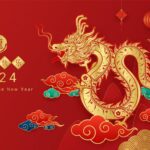Chinese New Year, also known as Lunar New Year or Spring Festival, stands as one of the most significant and widely celebrated festivals in the world. Rooted deeply in Chinese culture, this annual event symbolizes renewal, family reunions, and the welcoming of prosperity and good fortune. Its origins trace back thousands of years, blending myth, tradition, and historical events into a tapestry of cultural richness. This essay delves into the intricate history and multifaceted significance of Chinese New Year, exploring its ancient roots, traditional customs, and contemporary celebrations.
Ancient Origins:The origins of Chinese New Year can be traced back to ancient China, where it emerged from a blend of religious, agricultural, and cultural practices. One prominent legend surrounding its inception is the myth of Nian, a mythical beast that would terrorize villages every New Year’s Eve, devouring crops, livestock, and even humans. To ward off Nian’s attacks, villagers began hanging red decorations, setting off firecrackers, and lighting bonfires, believing that the creature feared the color red, loud noises, and fire. Over time, these customs evolved into integral parts of the Chinese New Year celebration, symbolizing the triumph of light over darkness and the expulsion of evil spirits.
Another legend associated with the festival is the story of the Jade Emperor, ruler of heaven, who ordered that the twelve animals who arrived first at his palace would be assigned to the Chinese zodiac. As a result, each year in the lunar calendar is named after one of these animals, leading to the twelve-year cycle that forms the basis of Chinese astrology. The Chinese zodiac plays a significant role in Chinese New Year celebrations, with each year being associated with specific traits, characteristics, and fortunes.
Traditions and Customs:Chinese New Year is characterized by a myriad of traditions and customs that vary across regions and communities but share common themes of renewal, reunion, and auspiciousness. Preparations for the festival typically begin weeks in advance, with families cleaning their homes to sweep away bad luck and make way for good fortune. This practice, known as “sweeping the dust,” symbolizes the cleansing of the old year and the welcoming of the new.
One of the most iconic customs of Chinese New Year is the giving and receiving of red envelopes, or “hongbao,” containing money as a symbol of good luck and prosperity. These envelopes are typically exchanged between family members, friends, and colleagues, with the amount of money often bearing significance based on superstitions or cultural norms.
The festival is also marked by elaborate feasts featuring traditional dishes symbolizing abundance, wealth, and happiness. Dumplings, for example, are a staple of the Chinese New Year menu, with their shape resembling ancient Chinese ingots and thus representing prosperity. Other popular dishes include fish, which symbolizes surplus and wealth, and sticky rice cake, or “nian gao,” which signifies growth, advancement, and a higher position in the coming year.
Fireworks and firecrackers are integral to Chinese New Year celebrations, serving both practical and symbolic purposes. Historically, these loud noises were believed to scare away evil spirits and ensure a peaceful transition into the new year. Today, fireworks displays light up the night sky in cities and towns across China and in Chinese communities worldwide, captivating audiences with their spectacle and symbolism.
Family Reunions:Central to the spirit of Chinese New Year is the concept of family reunion. For many people in China and the Chinese diaspora, the festival represents a time to return home, reunite with loved ones, and honor ancestors. The eve of Chinese New Year, known as “Chuxi,” is traditionally spent gathered around the family dinner table, sharing stories, exchanging blessings, and enjoying each other’s company.
The significance of family extends beyond immediate relatives to include extended family members and ancestors. Ancestor worship is an integral part of Chinese culture, with offerings of food, incense, and prayers made to honor departed loved ones and seek their blessings for the coming year. Ancestral tablets are often placed prominently in family homes, serving as focal points for reverence and remembrance during the New Year festivities.
Spring Festival Gala:A modern tradition that has become inseparable from Chinese New Year is the Spring Festival Gala, or “Chunwan,” broadcast annually on Chinese state television. First aired in 1983, the gala has since become one of the most-watched television events in the world, attracting hundreds of millions of viewers both in China and abroad.
The Spring Festival Gala features a diverse array of performances, including skits, musical numbers, dance routines, and acrobatic displays. Celebrities, entertainers, and cultural icons from China and beyond come together to showcase their talents and celebrate the spirit of the New Year. The gala’s lineup reflects the cultural diversity and dynamism of contemporary China, incorporating elements of traditional Chinese opera alongside modern pop culture phenomena.
The gala’s popularity lies not only in its entertainment value but also in its role as a unifying force for the Chinese people, fostering a sense of national pride and solidarity. Families gather around their television sets to watch the gala together, laughing, singing, and sharing in the collective experience of ushering in the New Year. In recent years, the Spring Festival Gala has also embraced digital technologies, with online streaming platforms enabling viewers to watch and interact with the show in real-time.
Global Impact: While Chinese New Year is deeply rooted in Chinese culture, its influence extends far beyond China’s borders, thanks to the global reach of the Chinese diaspora and the popularity of Chinese culture worldwide. From bustling Chinatowns in cities like New York, London, and Sydney to remote communities in Southeast Asia, Africa, and the Americas, Chinese New Year is celebrated with fervor and enthusiasm by millions of people of Chinese descent.
In multicultural societies, Chinese New Year has become a symbol of diversity and inclusivity, with people of all backgrounds joining in the festivities. Parades, street fairs, and cultural exhibitions showcase the vibrant traditions of Chinese New Year, inviting people to learn, participate, and celebrate together. In schools and workplaces, Chinese New Year is increasingly recognized and celebrated as a multicultural holiday, fostering cross-cultural understanding and appreciation.
The economic impact of Chinese New Year is also significant, with businesses around the world gearing up for increased consumer spending on gifts, decorations, and festive foods. Retailers offer special promotions and discounts to attract shoppers during the holiday season, while tourism agencies promote travel packages and cultural experiences centered around Chinese New Year celebrations.
Conclusion: Chinese New Year stands as a testament to the enduring power of tradition, community, and cultural heritage. Across millennia, this ancient festival has evolved and adapted to changing times, yet its core values of family, prosperity, and renewal remain as relevant as ever. As the world becomes increasingly interconnected, Chinese New Year serves as a bridge between past and present, East and West, uniting people of diverse backgrounds in a shared celebration of hope, joy, and the promise of a new beginning. As we usher in each Lunar New Year, we are reminded of the timeless wisdom and enduring spirit encapsulated in the words: “Xin Nian Kuai Le” – Happy New Year!











Ive read several just right stuff here Certainly price bookmarking for revisiting I wonder how a lot effort you place to create this kind of great informative website
I just started reading this amazing website, they produce high quality content for people. The site owner works hard to engage customers. I’m delighted and hope they keep up the good work!